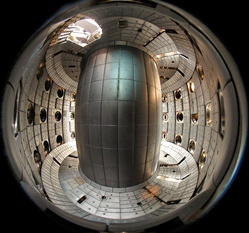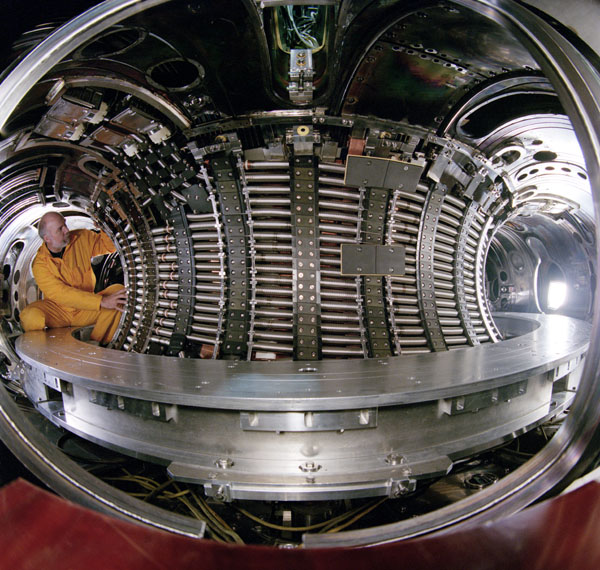Confinement Systems
In magnetic confinement systems, an approach to fusion power generation, a plasma of light atomic nuclei is heated and confined in a tokamak, where it is controlled with strong magnetic fields. CER’s confinement system collaborations involve three ongoing research program: DIII-D, NSTX, and TCV. TEXTOR is a past collaboration which is no longer in operation.
DIII-D

The DIII-D Research Program's mission is to optimize the tokamak approach to fusion energy production. Located in San Diego, the DIII-D National Fusion facility is the largest operating tokamak in the United States.
Operated by General Atomics for the U.S. Department of Energy, DIII-D is an international program with 90 participating institutions; the Center for Energy Research is the largest University collaborator on this project. Our research focuses on understanding the flow of heat, particles, and momentum across the confining magnetic field to the tokamak wall.
 NSTX : National Spherical Torus Experiment
NSTX : National Spherical Torus Experiment
The National Spherical Torus Experiment (NSTX) is an innovative magnetic fusion device being used to study the physics principles of spherically shaped plasmas -- hot ionized gases in which nuclear fusion will occur under the appropriate conditions of temperature, density, and confinement in a magnetic field.
Located at the Plasma Physics Laboratory (PPPL), research on NSTX is conducted by a collaborative international research team of physicists and engineers. Building on the world-class expertise acquired from DIII-D, PBX-M, TEXTOR, TCV, CCT, and CER’s own PISCES group, UCSD’s activities at NSTX are based on a physics program that includes elements of fusion science addressed by the PT plasma.
 TCV : Tokamak à Configuration Variable
TCV : Tokamak à Configuration Variable
Located in Switzerland at École polytechnique fédérale de Lausanne, the TCV tokamak aims to apply highly specialized plasma shaping and heating capabilities to the physics of magnetically confined plasmas. This directly supports the ITER project while charting alternative paths that may be required beyond ITER on the way to a prototype fusion reactor.
TEXTOR : Tokamak Experiment for Technology Oriented Research

The Forschungszentrum Jülich's program on Nuclear Fusion and Plasma Research was carried out at TEXTOR, a facility of the Institute of Plasma Physics (IPP). The program at IPP concentrated on a key problem of fusion power plant development -- the interaction of hot plasma with the containment chamber wall. Confronting this challenge involved addressing the need for heat transfer to the wall, and the removal of particles and “ash” (helium formed by deuterium fusion in the core of the plasma) from the plasma.
